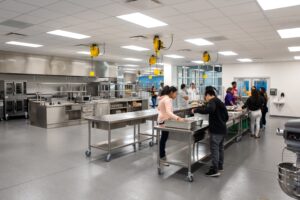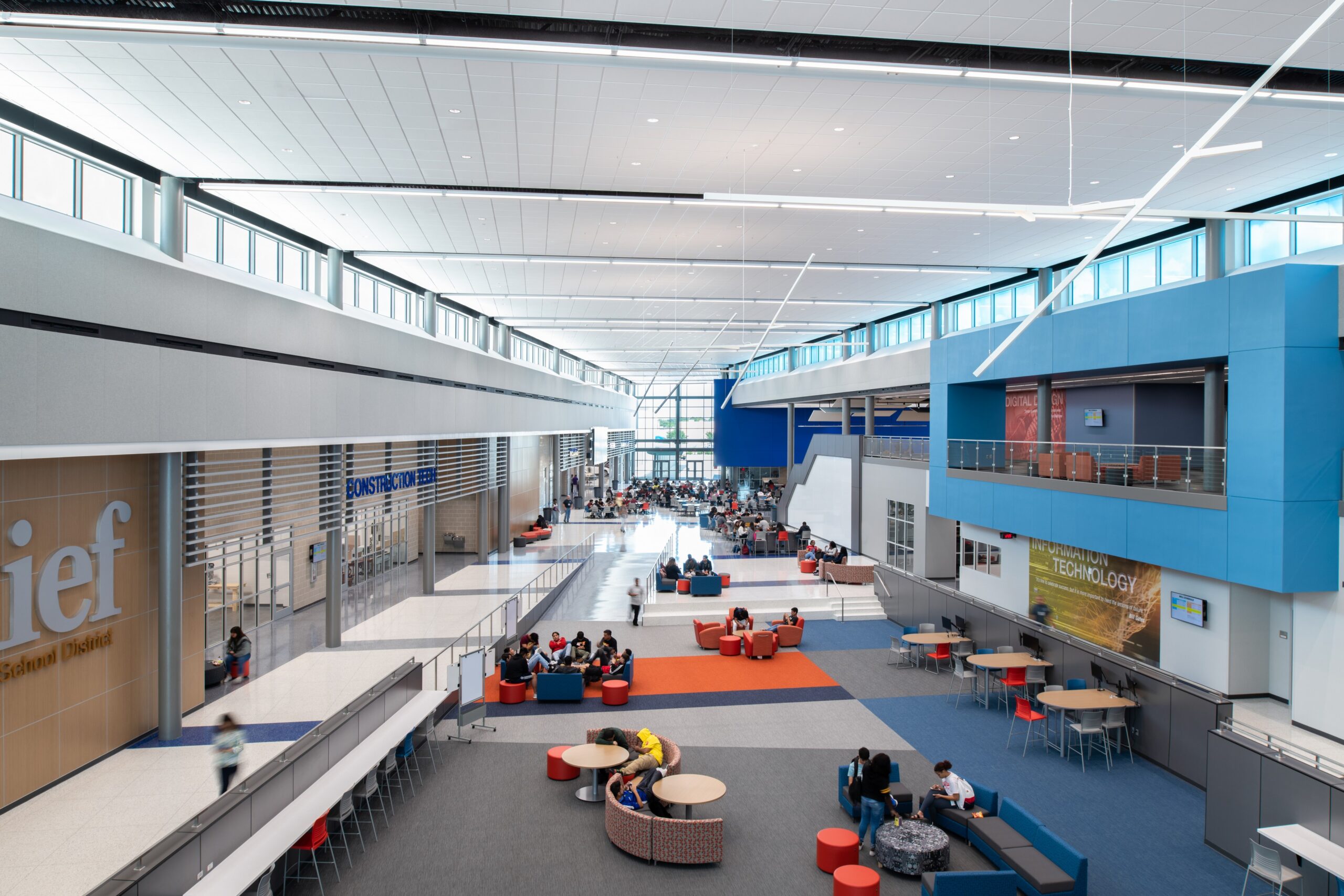By Lindsey Coulter
February marks National Career and Technical Education (CTE) Month, bringing awareness to the benefits that CTE offers to students and the opportunities it presents to schools and workforce partners. An estimated 12.3 million students are currently enrolled in CTE programs nationwide, where they can acquire training in a variety of trades and earn certifications that offer immediate employment opportunities upon graduation. At the same time, helping students develop skills that are relevant to the careers and industries in their regions can help employers address labor shortages.
Among recent successful and impactful CTE projects are the Game Development and Design School in North Texas’ Burleson Independent School District (ISD); Park City High School’s new CTE Wing in Park City, Utah; and the Alief Center for Advanced Careers in Houston’s Alief ISD.
“CTE projects are exciting because they allow (designers) to break away from traditional educational design and create spaces that push the envelope to a new dimension,” said Brandon Ross, AIA, LEED AP, managing partner at the Houston office of national architecture firm PBK. “These spaces add a layer of real-world impact by giving school districts the opportunity to incorporate industry-grade equipment and hands-on learning experiences. The challenge of balancing students’ educational needs with industry standards keeps the design process fresh and innovative.”
Ross and PBK design CTE centers (including the Alief Center for Advanced Careers) nationwide that mimic the actual workplace, providing students with real-world experience that traditional classroom settings can’t offer. To recognize National CTE Month and the valuable role CTE learning and spaces play in schools and communities, School Construction News spoke with Ross about designing CTE spaces that can bridge the gap between what students learn in classrooms and the skills required in the workplace.
SCN: Give that CTE facilities generally include a diversity of spaces, needs, equipment and functions, how do you approach the design/programming process?

Ross: CTE spaces are more than just classrooms—they are incubators for innovation, skill development, and real-world experience. Designing these facilities with flexibility, industry alignment, and student success in mind ensures that they remain valuable for years to come.
Unlike traditional K-12 projects, CTE facilities require a wider spectrum of input and engagement from additional user groups to make sure the spaces align with local workforce needs. Collaborating with industry professionals, educators and students in the community is a crucial part of the design process because CTE projects need to prioritize flexible and adaptable spaces that can accommodate multiple uses over time.
SCN: Do CTE facilities require a different approach when it comes to designing for safety and security?
Ross: We approach safety and security quite differently for CTE projects because they will see transient visitors due to the community and public access to the programs in these facilities. We create layouts that promote visibility and reduce blind spots. Since these buildings often contain specialized equipment and hazardous materials, we incorporate clear zoning and controlled access points to enhance supervision. Fire safety, ventilation and emergency shutoff systems are also integrated in CTE projects to mitigate the common risks associated with technical training spaces.
SCN: In places where students are studying careers and trades of the future, how can clients and design teams plan these spaces with future expansion, new technologies and flexibility in mind?
Ross: This is the most difficult part of designing CTE centers: It’s all about planning for the unpredictable. It’s important to prioritize modular and adaptable spaces that can be easily reconfigured as industry needs evolve. PBK incorporates open lab areas and flexible infrastructure that allow for the seamless integration of emerging technologies. These design strategies ensure that schools can adjust their programs for years to come.

SCN: What are some other common challenges related to developing CTE spaces?
Ross: The sheer amount of materials and equipment that come with building CTE spaces can be challenging. CTE centers need more air conditioning circulation and the learning environments themselves must be spread out for safety. There will be a variety of spaces, some small (like a science lab) and others large (like a welding classroom). This variance in volume creates potential structural challenges. Meticulous planning and pulling in industry leaders are key to combating these problems.
SCN: Do CTE spaces naturally lend themselves to sustainability and efficiency efforts?
Ross: CTE spaces often present unique opportunities for sustainability. Many programs focus on green technologies, renewable energy and efficient building systems—allowing students to learn about sustainability hands-on. Features like solar panels, rainwater harvesting and energy-efficient HVAC systems reduce operational costs and serve as educational tools for students studying these industries.
SCN: How can CTE spaces help uplift entire communities and not just students? Are they generally good investments for school districts?
Ross: CTE centers are an opportunity for everyone in the community to interact. Many CTE centers offer community access to resources such as job training programs and industry certifications—not only having an impact beyond students but also making them valuable investments for school districts. These programs also create direct pathways to employment, in turn, addressing labor shortages and strengthening the local economy.
SCN: Are there any funding strategies, programs or mechanisms that can help schools defray CTE project costs?
Ross: Partnering with industry leaders is the best way to cut costs for CTE projects. Whether it’s through the donation of physical equipment or donation of time, CTE centers become cost-efficient when they collaborate with the local community. From an automotive group gifting used cars and parts to workforce leaders coming into the classroom and teaching the students themselves, industry support is one of the most influential mechanisms that can help schools defray CTE projects.
SCN: Do you anticipate that CTE projects will become more common at the high school level?
Ross: The appeal of CTE programs is growing rapidly as schools recognize the need to prepare students for in-demand careers. The path to success is not limited to going to a traditional four-year college anymore. I think we will see more communities create space for CTE opportunities reflecting their regional need for labor. There is a strong probability many districts will increasingly offer CTE programs at the high school level to provide students with early exposure to career pathways. As the workforce evolves, CTE spaces will continue to play a crucial role in bridging the gap between what students learn in the classroom and the skills required in the workplace.


